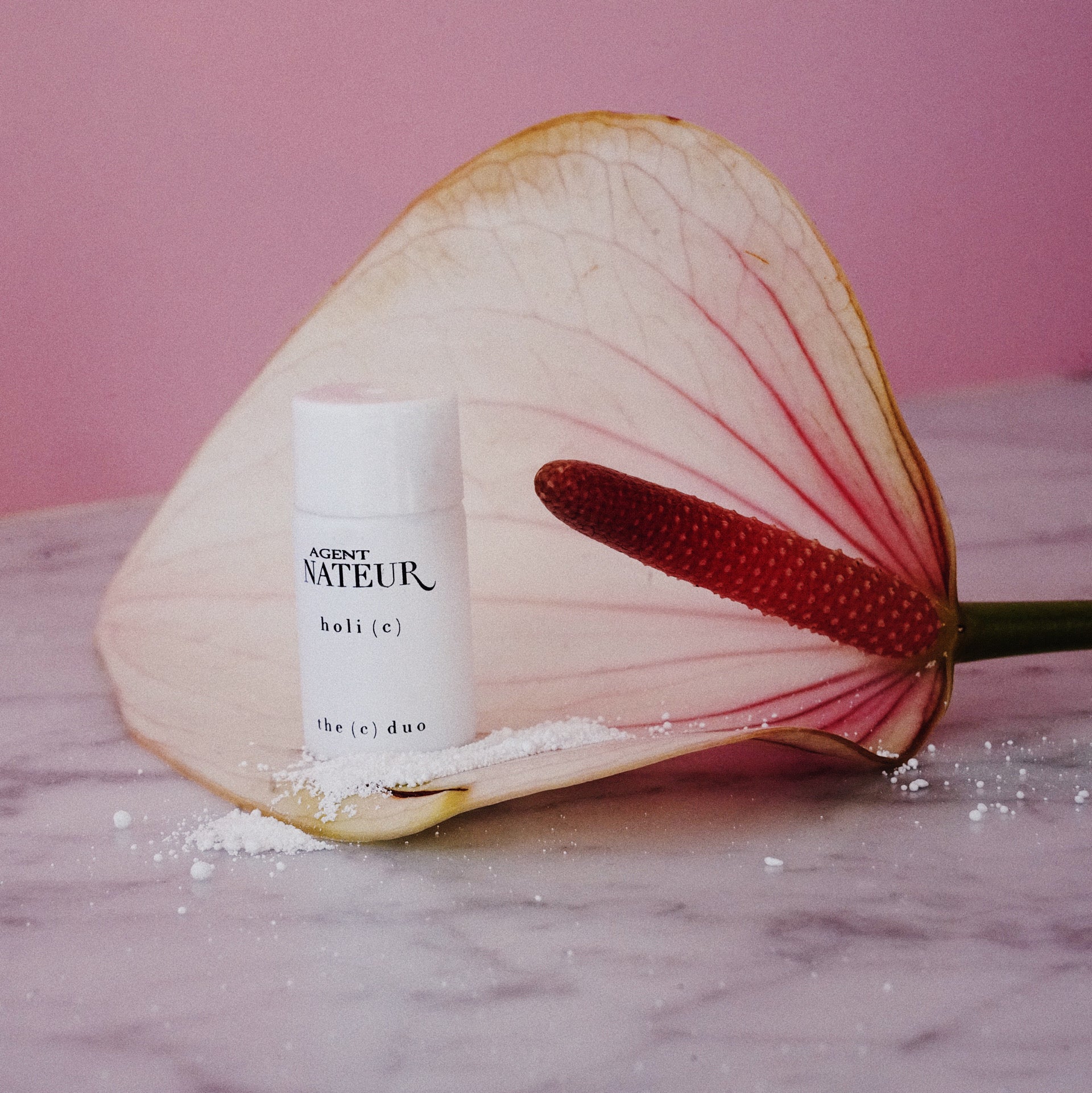6 reasons we choose sodium ascorbyl phosphate rather than ascorbic acid for our holi (c)

For many brands, Vitamin C is a critical player in their shelfie line up of consumer products (thanks to its strong power to reduce hyperpigmentation, ease breakouts, prevent premature aging, deliver photoprotection from UV A & B, inhibit melanogenesis, ease inflammatory skin disorders and clarify the texture of the skin - and more).
When brands say that a product is ‘Vitamin C’ based or ‘including Vitamin C’ - they are often referring to their product including some sort of derivative of Vitamin C, most likely to be:
In Agent’s superstar player, holi (c) - we incorporate just two ingredients - calcium ketogluconate (a French-patented natural complex molecule that helps restore the skin’s elasticity for a youthful, plump appearance) and Sodium ascorbyl phosphate (SAP).
Always out at the front of everything we do, we stand firm and proud in our formulation using SAP, when many other brands choose to use AA.
Today, we’re going to get into why.
When so many brands use AA, why does Agent use its derivative, SAP?
We use SAP because we understand the potential dangers and risks of spoilage of a beautiful product by using AA.
What does spoilage mean?
AA is unstable - and what this means is that under certain aerobic conditions (i.e. coming into contact with light and air - so, every day real life) AA can get oxidized.
Getting oxidized or oxidization means that the light and air cause a change in the molecular structure of an ingredient and when AA becomes oxidized, it oxidizes to:
If this oxidation occurs, and oxalic acid is what you end up with - we can all agree that oxalic acid is not what the chemists meant to be topically applied and absorbed by your face.
High oxalate levels in the body can cause a number of follow on symptoms (such as pelvic pain, kidney stones, kidney crystals, etc) - so the potential implications and side effects of unknowingly adding to our oxalate levels each day through our skincare, can’t be ignored.
For this one major reason - this is why, at Agent, we use sodium ascorbyl phosphate (SAP) in our powerful holi (c) - rather than the AA counterpart.
We trust in SAP’s stability, we trust in its structure, and we firmly trust in our ability to avoid any products that even hold the potential to do harm, rather than good, to our Agent Army.
What we love about SAP, rather than AA
1. If you couldn’t tell already, it is the most stable form of vitamin C
It’s as simple as that.
When tested directly against ascorbic acid and also other vitamin C derivatives and extracts (including ascorbyl palmitate and magnesium ascorbyl phosphate and), SAP has been shown to be the most stable form of Vitamin C.
We ensure that our product is more stable and less likely to oxidize very easily in the presence of light or air - than our competitors.
2. It is less irritating
Where L-Ascorbic acid penetrates your skin when applied topically, SAP actually converts into ascorbic acid once it is applied onto your skin.
What this means is that whilst l-ascorbic is more bioactive (remember the risks though), SAP is actually less irritating - meaning it is a way more beneficial choice for those with sensitive skin or those who deal with inflammatory face conditions in any format (i.e. rosacea), etc.
3. It is the most effective at preventing outbreaks
Because of its stability, studies have shown that SAP is the most effective derivative at preventing the proliferation and growth of microorganisms like yeast and mold, as well as preventing the growth of bacteria that causes breakouts. (1)
In fact, in vivo studies, SAP prevented sebum oxidations up to 40% and ultimately proved in this study to be more effective than commonly prescribed acne medications. (2/3)
In another study, when used for a period of 90 days, SAP reduced facial sebum secretions, leaving the complexion less oily and acne-prone. (4)
4. It effectively reduces the signs of aging
Sodium ascorbyl phosphate reduces signs of aging and due to the fact it doesn’t oxidize - it is more likely to do so than its alternative derivative counterparts.
The power of the clinically-proven potent antioxidant, SAP, works to neutralize free radicals to prevent skin concerns like fine lines, loss of elasticity, and age spots (5)
5. It’s anti-inflammatory AF
Sodium ascorbyl phosphate reduces inflammation.
In double-blind and randomized studies, SAP has been shown to reduce inflammatory lesions by 20.14% after four weeks of use, and 48.82% after eight weeks. (6)
This reduction of inflammation ultimately calms irritated skin, providing an opportunity for rest and repair.
6. Its a power player against the damaging effects of UV-A and UV-B radiation
SAP protects the skin against degenerative radiation (such as UV-A and UV-B that we come into contact with every day).
In vitro studies confirmed this - showing that SAP holds the ability to penetrate deep within the dermis, defending against the damaging effects of UV-A and UV-B radiation on the skin. (7)
-----
How to use holi c
If you haven’t already noticed, we use a unique dry formula that is even MORE stable than normal emulsions and mixtures - taking it one step further to ensure that its restorative and regenerative benefits are never impacted with use.
Ideal Agent pairing
***THESE STATEMENTS HAVE NOT BEEN APPROVED OR REGULATED BY THE FDA. WE ARE NOT DOCTORS, THEREFORE ALWAYS CONSULT WITH YOUR DOCTOR FIRST.





